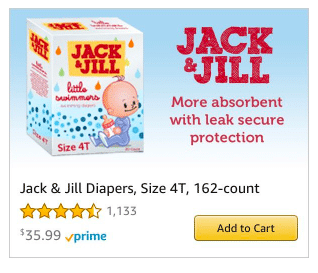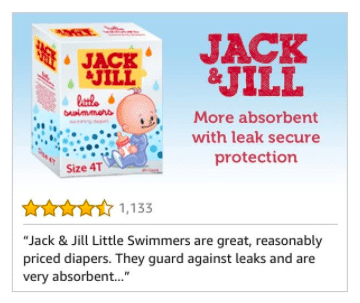Responsive eCommerce creative is a new ad format that bring a lot of benefits to your current ad strategy. It will enable you to auto-generate ads on eCommerce display ad creative.
It can feature up to 20 products and automatically skips the rendering of a product that is out of stock. This feature is available to all advertisers on Amazon DSP.
Today we’ll show you how this new feature works, and we’ll give you some tips to make the most of this service.
DSP and Responsive eCommerce Creative
Responsive eCommerce creative will allow you to select and deselect up to 10 supported sizes. This works both onsite and offsite Amazon DSP.
Plus, you can track your campaign’s performance. This works across each placement size via the Amazon DSP report center.
DSP stands for Demand-Side-Platform. First, it provides Amazon merchants with off-Amazon advertising opportunities. Second, it provides access to Amazon customer data for advertising purposes to brands that don’t sell on Amazon.
It has been a key platform pushing Amazon into the mixed media advertising sector.
Programmatic advertising is a sprouting industry. It is more important in today’s digital-focused economy. Amazon DSP launched in 2020. It has developed rapidly since then. Developments include significant updates to API integrations. These aim to simplify the extraction and updating of datasets.
This post will further dig into the four main categories of development. You can use this information to make projections about how this platform will develop throughout 2021.
Related content: How To Use Amazon DSP Audience Builder
Why You Should Use Amazon DSP
Now we know what a Demand-Side-Platform (DSP) is. Let us dive into why Amazon DSP will benefit you as an advertiser.
DSP uses exclusive Amazon audiences to reach new and existing customers on and off Amazon. It programmatically reaches your audiences across both Amazon-owned sites and apps. Some of these apps include IMDb and leading publishers’ sites.
You can reach audiences through direct inventory from Amazon Publisher Services. It also works with third-party exchanges. It may also appear in brand-safe environments. Amazon upholds quality standards and brand safety. They use both their own and third-party solutions, which include manual site reviews and real-time bid evaluation.
You can also be assured of unique access as well as high-quality inventory.
And above all, it helps build a metrics-based strategy. Amazon provides audience insights and performance. They show before and after campaigns to help you understand what’s driving results in your campaigns. These features come at no extra cost at all.
DSP Availability
Amazon DSP is available to both advertisers who sell products on Amazon and those who do not.
Self-service and managed-service options are available. How do the two differ from one another? Self-service customers have full control of campaigns. Managed-service customers have access to Amazon DSP inventory with consultative service. It is also designed for companies with limited programmatic advertising experience. The basic managed-service option requires a minimum spend of $35,000 USD. Note that the minimum may vary per country.
Amazon DSP is available in North America (CA, MX, US); South America (BR, Europe, DE, ES, FR, IT, NL, UK); Middle East (UAE); Asia Pacific (AU, IN, JP).
For more information and to register for Amazon DSP, you may contact an Amazon Advertising account executive.
DSP for Advertising
You can make use of Amazon DSP to support a wide variety of advertising goals. Let’s say your your goal is to drive brand awareness and expand your reach.
If so, you could reach new customers off-site with a video. It would introduce your brand and top-selling products. You may have audiences that already visited your product page. In this case, you can remarket to them on Amazon. On Amazon, they are likely to be in the mindset to buy. This is more likely to lead to conversion.
Amazon DSP is also good for advertisers who want to programmatically buy display, video, and audio ads at scale.
DSP Improvements
DSP evolved from the siloed AAP (Amazon Advertising Platform). AAP was somewhat difficult to use. Amazon now seems focused on bringing more balance to the interface. Amazon also seems to want to make DSP more user-friendly. The platform has an array of new features and functions. There are two significant updates worth mentioning.
Bulk upload and editing
Amazon has been trying to move away from manual updates on DSP. This is one big improvement. It helps agencies and large corporations. This is especially true if they are working with many campaigns and potentially hundreds of ASINs. Bulk uploading and editing are now easier than they used to be. It’s also an essential step towards automating uploads and downloads using an API.
Bulk editing of targeted device type: Imagine, you can now update the targeted device type for standard display and video line items in bulk. This will save you a lot of time.
Bulk edit of supply bids and total budget: You can decrease or increase the supply bids (base and max) and total budget for several line items with one action.
Bulks sheets for DSP campaign management (US beta): Create and update standard display line items and associated creatives. Import and export line items for a single order, advertiser, or across multiple advertisers. This enhancement done in DSP is truly a remarkable one.
Goal KPI during order creating
Amazon DSP orders now need you to select a goal KPI when generating an order. You can choose a metric from the drop-down during the new order set up to put a goal KPI in place. More automated optimizations and recommendations are also allowed. This significantly improves outcomes for inexperienced users.
Like Google Smart Shopping, the setting of KPI goals is a sign of the move to a more AI-based service. This brings far greater efficiency for experienced users. It also improves the learning curve for new DSP advertisers. These positive changes make the platform more accessible, more efficient, and user-friendly. The outcome will likely be more users and greater competition.
Amazon DSP Strategy Audit
Amazon wants to further expand the creative availability to advertisers. It also wants to make these creative tools easier to use. Amazon is building in flexibility for Amazon-created ad options. This includes e-commerce creative templates or video creative builders.
Video ads
Although still in beta. Video creative builder will bring out the creative side in you. You may choose from their existing templates. You can also use product images found on your product detail page, you can create an engaging video ad.
Auto generating creatives
This will give you the flexibility to choose. You can use Amazon creative options or simply use your own custom ads. E-commerce creatives can include an image or a product image found on a product detail page. Responsive e-commerce creative with brand logos and headlines can now also be customized.
In-line messaging
In-line messaging (ILM) is also available for e-commerce creatives. This includes responsive e-commerce creatives (REC) and dynamic e-commerce ads (DEA). Detail page ILM shows above-the-fold placements at the top of product detail pages.
This year, we can expect more variants of ad creatives to be released for you to use. Changes to ad creatives will further create opportunities for brands to stand out in new and exciting ways. Amazon is moving away from a rigid templated approach. The platform now has more dynamic and brand-appropriate presentations. Ad content and presentation will be critical to differentiation for Amazon Sellers in 2021.
So, Amazon must carry on with these developments for sellers’ benefit.
Here are some examples of these improvements:
Desktop Ads
In all options the star rating and total reviews number are clickable.
Add to cart

Pre-order Add to Cart

Coupons

Customer Review

Shop Now

Responsive eCommerce Creative | New targeting options
Advertisers will need to adapt and evolve their targeting. Consumers nowadays continue to shift the way they buy online. More online marketplace Sellers are entering the market.
The numbers are expected to rise in 2021. Making the best use of Amazon’s unique data will be essential. Without it, it will be hard to reach, know and pinpoint your target audience and start from there.
Below you will find some recent additions. We can probably expect more by the end of Q1 2021.
Audience discovery
For audience exploration and management, use The Audiences tab to explore and search across audiences:
- In-market
- Lifestyle
- Custom built
You may also browse and sort audiences by forecasted reach and impressions, or creation and modification date.
Prime Video signals in Audience Builder
This feature will help enable engagement from audiences that are streaming films related to brand offerings. It helps define your audience based on Prime Video content as well as more usual retail indicators. These include keyword searches, product views, and sales.
Video completion targeting
Amazon Advertising’s video completion targeting allows you to select the granularity of the video completion rate you need.
In-market audiences
You can now engage audiences that have recently considered products in a given category.
Custom-built audiences
A new tab labeled “Custom-built” provides access to audiences based on specified Amazon shopping or streaming indicators.
Interest Audiences (launched in the US)
“Interest audiences” helps promote awareness even to audiences that have only shown an interest related to your product.
Amazon has access to the largest global database of online shoppers. Because of this, it’s coming under strict scrutiny from regulators. They are looking at how Amazon uses this position, especially in some continents such as Europe. Sharing access to targeting algorithm results and data will be one way the company can exhibit openness. This year, expect more and more comprehensive targeting options to be at one’s fingertips.
Come to think of it, the more targeting options you have, the more valuable making the right choice becomes. Getting a handle on your Amazon customer data is key. This allows you to deliver positive outcomes with the new options. It also helps you to skip the increased competition on the platform.
Users need to understand the increased importance of knowing your target audience.
Focus on measuring impact and data exchange
Amazon is determined to introduce new features onto DSP. This will have a remarkable impact on all advertisers as well as the sellers. They will have to:
Keep up: New features would mean access to new markets, new segments, new ad vehicles. All the tactics and strategies will have to change accordingly.
Measure and change campaigns often: Advertising now requires automation and is more programmatic. So, advertisers will have to tie their systems more closely to Amazon through APIs. This will allow them to measure the impacts and update ads.
API updates
To retrieve reports for Amazon DSP campaigns, advertisers can leverage the new Amazon Advertising API. This API function will make it easier for advertisers to retrieve reports using their own preferred tools. They can also view campaign performance for them to check and review.
Full read/write access to this API may come out in Q1 of 2021. This further increases the versatility of this feature but this was still uncertain.
Integration
Overall, the Amazon Advertising Platform can be considered as a combination of three primary services:
- Amazon DSP
- Amazon Attribution
- Sizmek Ad Suite
Through the use of Sizmek Ad Suite, advertisers who buy media through Amazon DSP can reach and measure the effectiveness of their campaigns. Advertisers can access reporting and audience insights that show sales and conversion metrics on and off Amazon through the integration of Sizmek Ad Suite with Amazon Attribution
Pro-tip: Amazon also came up with the “Amazon Marketing Cloud (AMC). This service can be used to accumulate and analyze insights from multiple different sources.
Amazon is continuously renaming and rationalizing its ad services, AAP to DSP is a good example. Look out for developments in APIs and tighter integration between DSP, Attribution, and Sizmek. You may also expect the probability of some rebranding of offerings as well.
Users will now have the increased ability to understand the impact of their advertising and will be able to strategize and move their way up.
What is Responsive eCommerce Creative?
Amazon Advertising’s eCommerce display creatives automatically optimizes an ad’s format. This is to meet a particular campaign goal. Amazon Advertising offers two types of eCommerce display creatives. One is Dynamic eCommerce and the other is Responsive eCommerce creatives.
Both creatives make use of the primary product image found on the Amazon detail page. The variation of eCommerce creative served will be optimized through machine learning and selected line item goal type. This includes click-through rate, purchase rate, or detailed page view rate.
The Dynamic eCommerce creative also includes a customized background which is not available in Responsive eCommerce creative.
Once in a while, Amazon Advertising may test variations of the eCommerce elements, copy, layout, and design. The illustrations below show the standard formats and are not an exact representation of what your ad may look like.
Placements On-Amazon
Both Dynamic eCommerce and Responsive eCommerce creatives are available in the following ad placements:
300×250, 160×600, and 300×600
- Homepage Above the Fold (ATF),
- Homepage Below the Fold (BTF),
- Search Skyscraper,
- Read All Reviews (RAR),
- Detail Page, and Thank You Page.
970×250 and 980×55:
- Homepage Below the Fold (BTF),
- Detail Page Below the Fold (BTF),
- Deals Page (ATF),
- Offer Listings Page (ATF),
- Detail page Inline Messaging (ILM).
They are also available in:
- 320×50, 414×125, and 300×250 placements on Amazon mobile web for smartphones,
- 320×50, 414×125, and 300×250 placements except the shopping results page on the Amazon Mobile Shopping app for smartphones.
Only Dynamic eCommerce is available to managed service advertisers in the US for the 650×130 and 245×250 ad placements for product image and the shop now variation.
Only Responsive eCommerce is available to all advertisers in all 650×130, 245×250, and 728×90 ad placements.
Placements Off-Amazon
The following as placements are available:
- Amazon Advertising display ad placements for 300×250, 160×600, 300×600, 728×90 sizes, and 970×250
- 320×50 and 300×250 sizes on mobile web and mobile smartphones
- 728×90 size is supported for mobile web on tablets.
Functionality
The main content area and product title are clickable; Upon clicking, the customer is taken to the relevant product detail page.
Take note that the product shown in the image must correspond to the product on the detail page where the ad will link to.
Please also note that Amazon Fresh, Pantry, Prime Now, and Prime Exclusive Deals products are not currently supported.
Lightning Deals, Deals of the Day, and Best Deals (Savings & Sales) are supported on the Shop Now variation when the product image is shown, see below.
Dynamic eCommerce: Self-service advertisers may include one Amazon Standard Item Number (ASIN) in an eCommerce creative. Managed service advertisers may include up to 5 ASINs in an eCommerce creative.
Responsive eCommerce: Advertisers may select up to 10 different creative sizes in an eCommerce creative. Advertisers may include up to 20 ASINs in an eCommerce creative. Products that are Out of Stock (OOS) will be automatically skipping the rendering of an ASIN that is out of stock. If all ASINs are OOS, it does not pause the creative and will show the best performing OOS ASIN.
Subscribe & Save coupons are not currently supported.
Coupon and Subscribe & Save badging are supported on the Shop Now variation when the product image is shown. In the case where the ASIN has multiple discounts, the highest available discount will be shown, look here.
For rules, restrictions, and click-through behavior on each e-commerce creative type available as part of an e-commerce creative, look here.
Responsive eCommerce Creative Limitations
Customizable ASINs are not supported in Dynamic eCommerce ads and custom-designed images and customer reviews are not supported in Responsive eCommerce creatives either.
Learn more about the Custom Image and e-commerce Section here.
Final Thoughts
As Amazon gets more loaded with brands, it is essential to stay ahead and be on top of the game. Being flexible and adaptable to the ever-changing digital world will make Amazon stand out.
It is a good thing that by being an early adopter of new ad betas and targeting abilities, you can get your footing with these new options and use them to the greatest extent possible. The earlier you can adopt, the better. Results are best shown when you adapt to the changes accordingly.
Basically, there will be many new opportunities created by DSP developments, and getting a grip on your data and advertising types is key to making the most of them.



